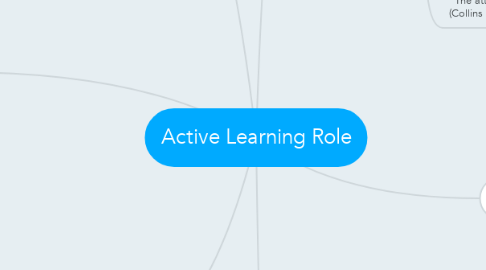Active Learning Role
by Diana Matthews

1. Broad Examples
1.1. Clickers
1.2. Active discussions
1.2.1. Discussion Boards
1.3. Group work
1.3.1. Discussion Boards
1.3.2. Group Feature
1.3.3. Pages (wikis)
1.4. Problem-based learning
1.5. Learning by teaching
1.5.1. Conferences
1.5.2. Pages (wikis)
1.6. Gamification
2. What We're Doing
2.1. Diana: "low-tech" clickers (colored paper)
2.2. Diana: SLS1101 library scavenger hunts
2.3. Diana: create a search engine tutorial
2.4. Diana: create an exam question
2.5. Cari: Conferences with an interview/dialogue
2.6. Cari: Bubblr
2.7. Cari: Kahoot
2.8. Cari: TinyTap
3. Specific Examples
3.1. Think-Pair-Share
3.2. Digital storytelling
3.3. Mind mapping
3.4. Muddiest Point
3.5. Note Check
3.6. Pretty much anything in the textbook!
4. Definitions
4.1. "Give the pupils something to do, not something to learn; and the doing is of such a nature as to demand thinking; learning naturally results” (Dewey, 1966)
4.2. "Active learning is generally defined as any instructional method that engages students in the learning process" (Prince, 2004).
4.3. "Shifts the focus of content structuring from the teacher...to the learner" (Leonard, 2002)
4.4. "Any situation in which students move around and do things, rather than sitting at their desks, reading, filling out worksheets, or listening to a teacher" (McBrien & Brandt, 1997)
4.5. "Learning which encourages the pupil or student to engage actively with what is being learned through activities such as group discussion, role play, or experimentation, rather than passively receiving and memorizing knowledge or instruction from the teacher..." (Wallace, 2008)
4.6. "The attainment of knowledge by participating or contributing" (Collins & O'Brien, 2011)
5. Benefits
5.1. "it leads to better student attitudes and im- provements in students’ thinking and writing" (Prince, 2004)
5.2. "cooperation improved learning outcomes relative to individual work across the board" (Prince. 2004)
5.3. "enhanced academic achievement and a number of attitudinal outcomes" (Prince, 2004)
5.4. "students will remember more content if brief activities are introduced to the lecture" (Prince, 2004)
5.5. "gain a far better understanding of the information then they would otherwise have" (Leonard, 2002)
6. Instructor Responsibilities
6.1. Have a clear idea of outcome/objectives
6.2. Set ground rules and clear instructions
6.3. If using groups, consider assigning them
6.4. Provide accountability, especially for group work
6.5. Check in and communicate
6.6. Evaluate effectiveness


